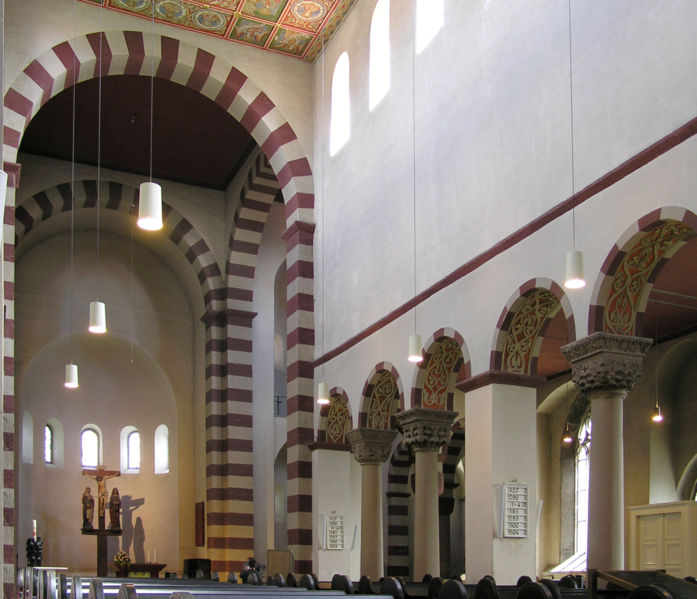
Reserved Area
Artists - ArtWorks
St. Michael of Hildesheim
 Germany
GermanyThis church marks the revival of building activities in the ottonique empire starting from 1000 a.d. The church was built in the time of bishop Bernward, who was the educator of emperor Otto III.
You can find it at the Western rim of the city centre of Hildesheim, on the St. Michael's Hill. You enter the church from south where the main entrance is situated. In annex to the church there is a monastery garden.
Around 1000 a.d. the church-building developed (1001 - 1031). It was constructed as the chapel of a benedictine monastery. The church was named after the "arch-angel" Michael, patron-saint of the deceased.
Bishop Bernward had planned to be burried at this cathedral. Bernward died in 1022, and his plans for the cathedral-building were carried out by his successor Godehard.
During the 13th century, the interior of the Hildesheim cathedral was enhanced further: In this period the wooden ceiling was created (1230, which shows the "roots of Jesse" (the genealogical tree of Jesus). It consist of about 1300 painted oak boards and streches over 27.8 x 8.7 m. , the so-called "Root of Jesse".
When the Reformation was adopted in Hildesheim in 1542, St. Michael's Church became Protestant, but the Benedictine monastery remained existing until it was secularized in 1803. The monks would still use the church and its crypt, which remain Catholic to this day.
St. Michael's church was destroyed during World War II, its rebuilt was begun in 1950 and completed in 1957. In 1985, the church became a UNESCO World Cultural Heritage site, along with the Cathedral of Hildesheim.
St. Michael belongs to the most important clerical buildings in Germany, as there are
- Stiftskirche St. Cyriakus (Gernrode)
- St. Pantaleon (Cologne)
- Krypta der St. Wiperti in Quedlinburg
- Eastern outbuilding of Mayence Cathedral (Mainzer Dom)
- West-entrance of the Essen Cathedral (Essener Münster)
With its clear dimensions and balance this cathedral exceeds various kinds of architectur. It is no more oriented to antiquity and reveals a much more cubic and stereometric conception. Though the cathedral still shows and "additve" composition of the different parts of the building, the proportions follow another system.
St. Michael is a three-nave basilica with two transepts (western and eastern). On its front you can find polygonal towers with a cylindric upper part. Above the crossings square central towers arise. The eastern choir is a short pre-choir with an apsis, along the east wall of the transept further apses can be found. The bigger west-choir is built over a hall-crypta.
- Total length: 74,75m
- Thickness of the walls: 1,63m
- Total length of the transepts: 40,01m
- Total width of the transepts: 11,38m
- Length of the nave: 27,34m
- Width of the nave incl. lower aisles: 22,75m
- Width of the nave without lower aisles: 8,60m
- Height of the nave without lower aisles: 16,70m
- Length of the crypt: 18,36m
St. Michael's Church is one of the most important churches in Ottonic style.
Hutter/Holläber: Belser Stilgeschichte, Band III
Hartmann-Viernich, Andreas: Was ist Romanik?, Darmstadt 2004
http://st-michaelis-hildesheim.de
http://welterbe-hildesheim.de/
http://deutsche-museen.de/unesco.php?uid=30
http://www.raymond-faure.com/Hildesheim/Hildesheim_Michel/hildesheim-Michel.html
http://193.175.110.9/hornemann/english/unesco_st_michael_innenansicht.php
Related Material:
Image available

File name: 51_Holzdecke St-Michael-Hildesheim.jpg
Description of the material:
818 × 2.537 Pixel, 764 KB, image/jpeg
Contextualisation Of the source:
the original source of this image can be found on Wikipedia under: http://de.wikipedia.org/w/index.php?title=Bild:Hildesheim-St_Michaels_Church-Wooden.Ceiling.jpg&filetimestamp=20050803074344
Interpretation of the source:
wooden ceiling of the St. Michaels-Church.

File name: 51_Innenansicht St-Michael.jpg
Description of the material:
2.257 × 1.941 Pixel 936 KB, image/jpeg
Contextualisation Of the source:
the original source of this picture can be seen at Wikipedia under: http://de.wikipedia.org/w/index.php?title=Bild:St.MichaelInnen.jpg&filetimestamp=20060701142245
Interpretation of the source:
St. Michaels-Church from the inside, view toward altar

File name: 51_Innenansicht St-Michael.jpg
Description of the material:
2.257 × 1.941 Pixel 936 KB, image/jpeg
Contextualisation Of the source:
the original source of this picture can be seen at Wikipedia under: http://de.wikipedia.org/w/index.php?title=Bild:St.MichaelInnen.jpg&filetimestamp=20060701142245
Interpretation of the source:
St. Michaels-Church from the inside, view toward altar

File name: 51_St-Michael-Aussenansicht.JPG
Description of the material:
500 x 388 Pixel image/jpeg 50 KB
Interpretation of the source:
St. Michaels-Chaurch seen from outside
Comments about this Artist/ArtWork
Date: 2009.04.27
Posted by Cecilia Geroldi
Message: The eleventh century is characterized by the massive development of Churches. The art is mostly architecture.This period is influenced Ottonian architecture and the power and importance that the Church had.The examples are more formed by the Church of St Michele in Hildesheim in Germany, like brass masterpiece of Ottonic style, and Abbey Of Cluny in France, as an example of the power and majesty of Christianity.These characteristics contribute to the development of the Romanesque style.
Michelangelo - Copyright 2008 - This project has been funded with support from the European Commission